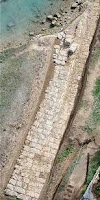Diolki: an ancient Greek engineering marvel that paved the way for railroads
Diolkos was an incredible feat of ancient engineering that revolutionized transportation in Greece. Built in the 6th century BC, it was a 4-mile (6.4 km) canal that connected the Gulf of Corinth to the Gulf of Aegina, allowing ships to avoid the treacherous journey around the Peloponnese peninsula.
Diolkos was built using a combination of canals, ramps and walkways. Ships were placed on wheeled platforms and pulled along rails by people or animals. This ingenious system made it possible to transport goods and people over land efficiently and safely, significantly reducing travel time and costs.
Diocles played an important role in the Greek economy, facilitating trade between the Aegean and Adriatic seas. It also served as an important military route, ensuring the rapid movement of troops and supplies.
Diolkos remained in use for more than 600 years until it was abandoned in the late Roman period. However, his legacy lives on as a testament to the ingenuity and skill of ancient Greek engineers. Diolkos is considered the forerunner of modern railways, and the principles of its design continue to be studied by engineers today. You can find more information about trade routes in ancient Greece.
Here are some additional details you can include in your article to make it even more interesting:
Diolkos was one of the largest construction projects of its time. This required the excavation of millions of cubic meters of earth and the construction of several tunnels and bridges.
Diolkos was a complex logistical operation. A large workforce was required to maintain the canal and tracks, as well as to operate the wheeled platforms.
The Diolkos had a significant impact on the environment. The construction of the canal led to deforestation and soil erosion.
Diolkos was eventually abandoned due to a number of factors, including the decline of the Greek economy, the rise of piracy and the development of new shipping lanes.




Comments
Post a Comment